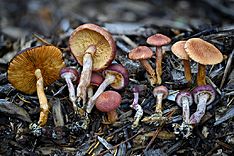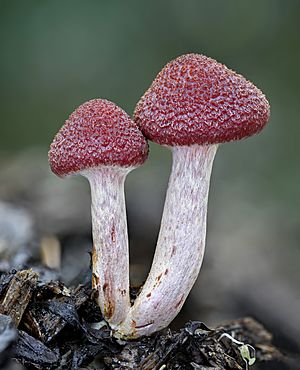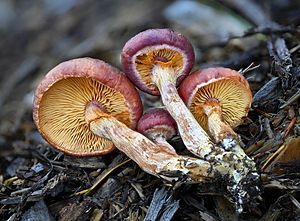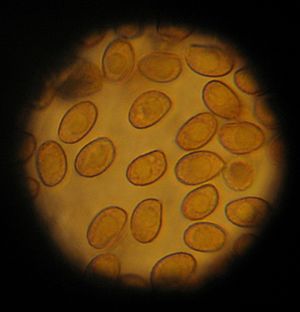Gymnopilus luteofolius facts for kids
Quick facts for kids Gymnopilus luteofolius |
|
|---|---|
 |
|
| Scientific classification | |
| Kingdom: | |
| Division: | |
| Class: | |
| Order: |
Agaricales
|
| Family: |
Hymenogastraceae
|
| Genus: |
Gymnopilus
|
| Species: |
G. luteofolius
|
| Binomial name | |
| Gymnopilus luteofolius (Peck) Singer (1951)
|
|
| Synonyms | |
|
|
| Gymnopilus luteofolius | |
|---|---|
| Mycological characteristics | |
| gills on hymenium | |
| cap is convex | |
| hymenium is adnate | |
| stipe has a ring | |
| spore print is reddish-brown | |
| ecology is saprotrophic | |
| edibility: psychoactive | |
Gymnopilus luteofolius, also known as the yellow-gilled gymnopilus, is a common and widespread mushroom. You can often find it growing in big groups on dead hardwood trees and conifers.
In eastern North America, this mushroom usually appears from late July to November. On the west coast, it grows during the winter months. This mushroom leaves a rusty orange spore print and has a bitter taste.
Contents
How It Got Its Name
The Gymnopilus luteofolius mushroom has had a few different names over the years. It was first described in 1875 by a scientist named Charles Horton Peck. He called it Agaricus luteofolius.
Later, in 1887, another scientist, Pier Andrea Saccardo, gave it a new name: Pholiota luteofolius. Finally, in 1951, a mycologist (mushroom expert) named Rolf Singer gave it the name it has today: Gymnopilus luteofolius.
What It Looks Like
The main part of the Gymnopilus luteofolius mushroom, called the fruit body, has a cap that can be reddish, purplish, or yellow. These caps are usually about 2 to 8 centimeters (1 to 3 inches) wide. They often develop green stains as they get older.
The surface of the cap is covered with small, tufted scales. These scales start out purplish, then turn brick red, and finally fade to yellow as the mushroom matures. The inside of the mushroom, called the context, is reddish to light lavender. It also fades to yellowish as the mushroom gets older.
Gills and Stem
The gills of this mushroom are attached directly to the stem (this is called adnate). They start out yellow and then turn rusty brown as the spores mature. The stem is the same color as the cap. It often looks dusty because of rusty brown spores.
The stem is usually 3 to 9 centimeters (1 to 3.5 inches) tall and 3 to 10 millimeters (0.1 to 0.4 inches) thick. It can be the same thickness all the way down or slightly wider near the bottom. The stem often has greenish stains near its base. As mentioned before, the taste of this mushroom is bitter.
Tiny Details: Spores and Cells
The spores of Gymnopilus luteofolius are bright rusty brown when they are collected in a spore print. They are very tiny, measuring about 6 to 8.5 micrometers long and 4 to 4.5 micrometers wide. They are shaped like an oval and have a rough surface.
The mushroom also has special cells called cystidia. These are found on the surface and edges of the gills, and also on the stem. They have different shapes, like flask-shaped or club-shaped. These tiny cell details help scientists identify the mushroom.
See also
 In Spanish: Gymnopilus luteofolius para niños
In Spanish: Gymnopilus luteofolius para niños
- List of Gymnopilus species




